TL;DR (Too long dont read) option: have a brief overview of this shrimp through a video!
Video adapted from Youtube. Creative commons.
1. Introduction
This page will introduce you to the Periclimenes brevicarpalis, otherwise locally known as the five-spot anemone shrimpTable of Contents
cnidarian (anemone) hosts. Its local common name, five-spot anemone shrimp may have been given due to its five orange spots outlined in black colour on its caudal fin (aka tail). This shrimp is known for its transparent body and association with anemones and can be encountered during inter-tidal walks on our local shores in areas such as Chek Jawa or Changi Beach Park.
For the hobbyist, unfamiliar words will be explained in common terms. Otherwise a link will be provided so you will be brought to a page which further explains the technical term. For the scientist, this page will hopefully cater to your scientific desire. Information on this page can be for everyone, however towards the end of the page it might get more technical. Please navigate to a section of your interest with the navigation panel on the right! Enjoy your stay!
2. Biology
2.1 Symbiotic interactions with invertebrate hosts
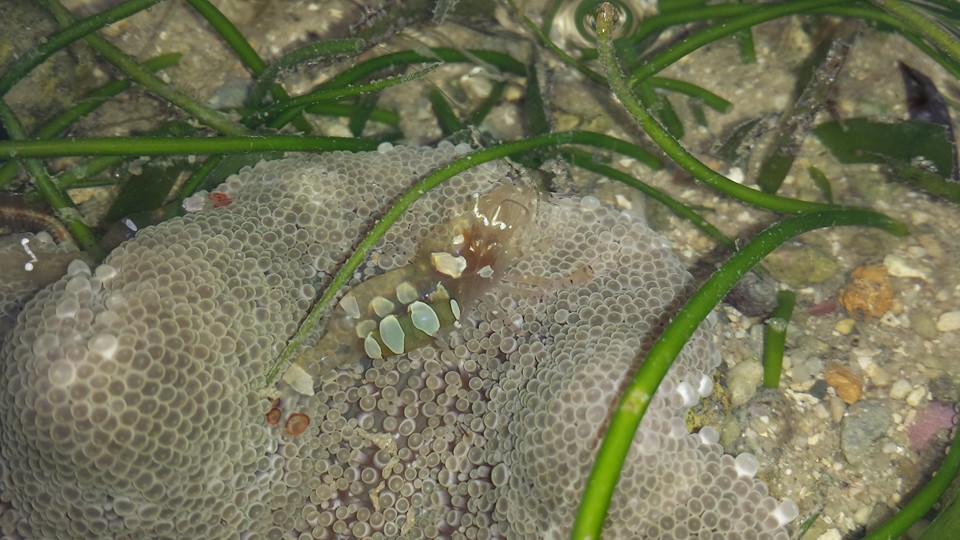 |
| Image by Pwa Keay Hoon. |
Adults of the P. brevicarpalis have been found inhabiting sea-anemones
belonging to the genus Thalassianthus, Stichodactyla, Entacmaea, Heteractis, Parasicyonis[1] , and rarely on the coral Acropora. The anemones may also host other shrimps or fishes such as Amphiprion and also porcellanid crabs. P. brevicarpalis, being a generalist, can be found on at least 8 different tropical anemone host. A single anemone often hosts a pair of P. brevicarpalis, and often one of each sex.
On the right is a pair of P. brevicarpalis inhabiting the Haddon's carpet anemone (Stichodactyla haddoni).
According to Holthuis (1952), the youngs of the species are found among weeds on high sea. By this method, the larvae can travel great distances before settlement, helping in dispersal.
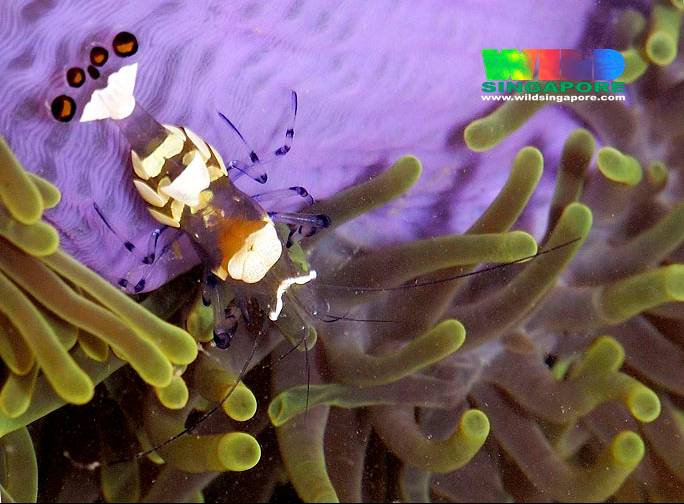 |
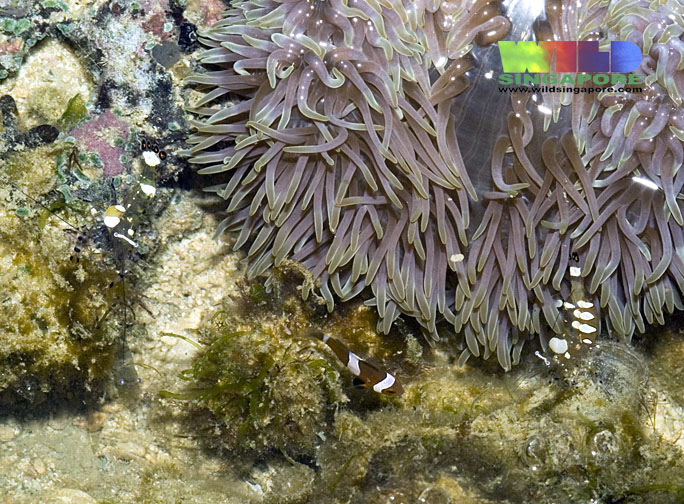 |
| P. brevicarpalis on a Magnificent anemone (Heteractis magnifica) on the left and on a Giant carpet anemone (Stichodactyla gigantea) on the right. Other commensals such as the Amphiprion fish (aka Clownfish) also shares its home, as shown on the right. Images by Ria Tan. |
|
2.1.1 A toxic relationship?
The relationship between these shrimps and their host is at present known to be symbiotic (interdependent), since studies have yet to prove if cnidarian hosts confers protection to the shrimp or if the shrimps are harmful to their host. However, the P. brevicarpalis has been documented to clip off the tentacles of the host therefore its relationship may be termed as parasitic (causing harm), although no serious damage can be found on the anemone in-situ (in the field). On the contrary, similar host associated shrimps of other genus have been found to benefit (in the case of Alpheus armatus) the host by protecting it from predation from annelid worms instead. This may be an instance of a love-hate relationship (except being immobile, the anemone cannot run away from a toxic relationship).2.1.2 Just a home or more?
Cnidarian hosts are often perceived as protection from predators for the shrimp in the wild. However, in laboratory experiments, P. brevicarpalis had reduced growth, longevity and fecundity without the presence of a host (despite being fed with other food sources). P. brevicarpalis larvae were also unable to develop ovaries in the absence of a host for settlement. This may suggest a more obligatory relationship of the host association in the P. brevicarpalis than only for protection from predation (aka being eaten up).2.2 Feeding habits
Periclimenes brevicarpalis being commensals (a relationship where one feeds off the other, much like in some romantic human relationships), feeds on the leftover food particles of the host. Although when food is scarce, this shrimp also feeds on the host it associates with. In the day, they can be found most often on the periphery of oral disc (top part of the anemone you most often see) on the anemone, clipping and eating its outer tentacles[2] . In the wild, this behaviour has not been observed to be especially harmful to the anemone as they often still retain their long and numerous tentacles[3] .Periclimenes brevicarpalis, although graceful and magnificent looking, also feed on each other. This behaviour is most noticeable after molting and in ex-situ (out of field) conditions when they were reared together in a tank. Cannibalism may not occur in the wild due to the fact that these shrimps are often only found in pairs on a single anemone. Or they may have already eaten the previous residents, who knows!
2.3 Reproduction
Ovigerous females can carry up to 4000[4] oval shaped eggs until they hatch. However insufficient space for accomodation of the clutch, as well as environmental stressors may induce brood loss.The association with an anemone may reduce brood loss during embryogenesis as it provides favourable conditions for embryo development[5] . This species has been observed to release approximately 300 youngs at once. The larvae of this species has a long pelagic larvae duration (PLD) and may settle only 35 days after hatching.While other species of Palaemonidae shrimps undergoes mark-time moults (where zoeal stage larvae moults multiple time without change in morphology but only in size) and sometimes skip stages, the development of P. brevicarpalis is noted to be much more regular.
2.3.1 Life stages
This table summarises the different life stages of the P. brevicarpalis days after hatching, with illustration for the last zoea stage to the first juvenile stage to show its transformation into an immature adult from a pelagic larvae.| Stages |
1st zoea |
2nd zoea |
3rd zoea |
4th zoea |
5th zoea |
6th zoea |
7th zoea |
8th zoea |
9th zoea |
Decapodid stage |
First juvenile stage |
|---|---|---|---|---|---|---|---|---|---|---|---|
| Days after hatching |
1-2 |
2-4 |
4-6 |
6-8 |
8-10 |
10-14 |
12-17 |
14-20 |
16-27 |
18-31 |
20-35 |
3. What may threaten the survival of this species?
Marine tropical decapod crustaceans are among the most popular invertebrate species in the aquarium trade industry. Due to its attractive colouration and its interesting host association, this species is an ornamental species. Some aquariums also promote them as having a peaceful temperament and being easy to care for, which may attract more buyers, increasing demand and eventually increasing harvesting from the wild. A google search will these shrimps at attractive prices below SGD20 and sometimes even with free shipping. While it is not known whether our local populations are being poached, other countries heavily involved in the aquaculture trade industry may be.Given the lack of understanding for culture techniques of these ornamental species and their obligatory host association, they are often harvested from the wild. This practice not only endangers the organism, but is also likely to impact the ecosystem due to their associative behaviours with other organisms. Sustainable management of the collection of ornamental species such as this will need to be implemented for their conservation[6] . Another sustainable solution is to convince marine aquarium hobbyists to rear shrimps which can be artificially cultured instead.
4. How do you tell if you are looking at the right species?
4.1 How to tell it apart from closely related species
This species closely resembles Periclimenes inornatus and Periclimenes ornatus, however it may be distinguished by its size and position of the dorsal and terminal spines of the telson[7] . For example in the P. brevicarpalis, dorsolateral spine of the telson is on the proximal half of the telson length while that of P. ornatus is on a third of the telson length[8] .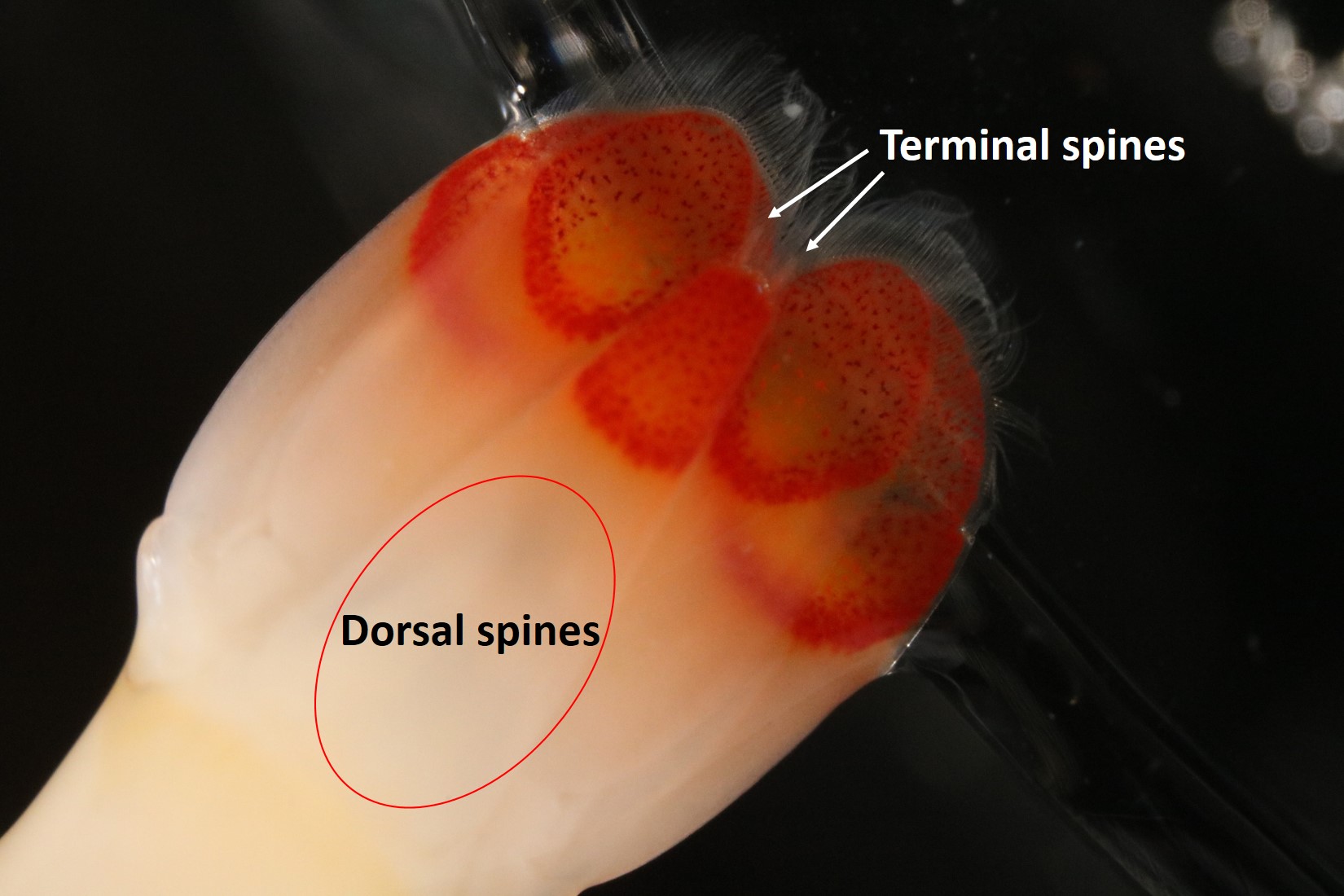 |
| Adapted from image by Pwa Keay Hoon, illustrating the region where dorsal telson spines are found and indicating the location of the terminal telson spines. |
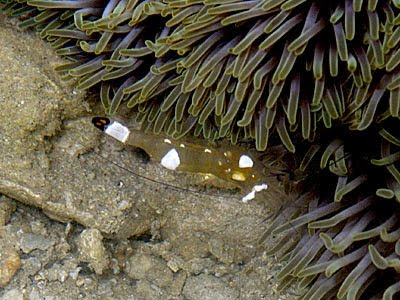 |
|
| P. inornatus versus P. brevicarpalis, bearing some resemblance to each other. Image by Ole Johan Brett (on the left) and Ron Yeo (right). Permission granted. |
|
4.2 Detailed description of the organism's appearance
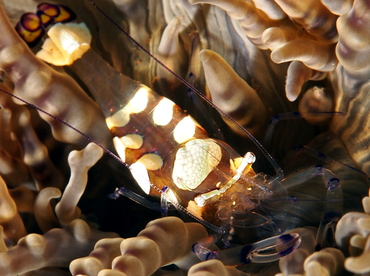 |
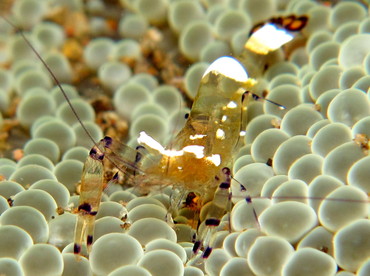 |
| Images of a female specimen in Bali, Indonesia. Image by Florent Charpin, pending permission. |
Image of a male specimen in Dumaguete, Philippines. Image by Florent Charpin, Pending permission |
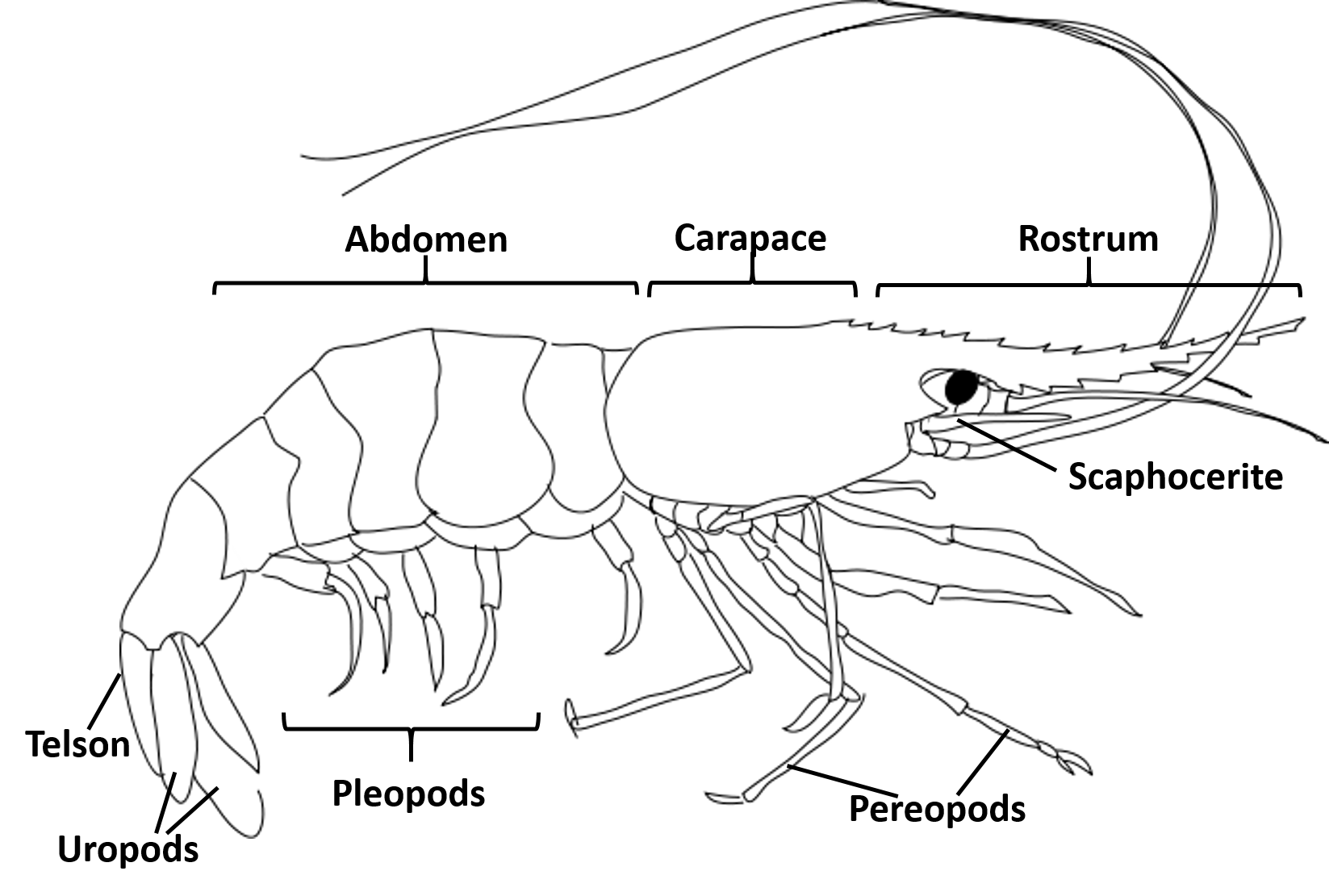
For the shrimp taxonomists, here are some of the key characteristics for the identification of the Periclimenes brevicarpalis according to a taxonomic key by Chace and Bruce (1993)[9] :
- Carapace without supraorbital or postorbital tooth
- Second pereopod without acute distal tooth on flexor margin merus
- Posteriormost tooth of dorsal rostral series not widely separated from rest of series
- Hepatic spine not extending beyond anterior margin of carapace
- 3rd pereopod without denticulate lobe on flexor margin of dactyl
- Third pereopod with dactyl simple, not biunguiculate
- Rostrum with midrib nearly horizontal, directed more anteriad than anteroventrad
- Rostrum with dorsal margin distinctly convex
- First pereopod with fingers pectinate on opposable margins
- 2nd pereopod with fingers nearly as long as palm, carpus 1.5 times as long as distal width
4.3 Color in life
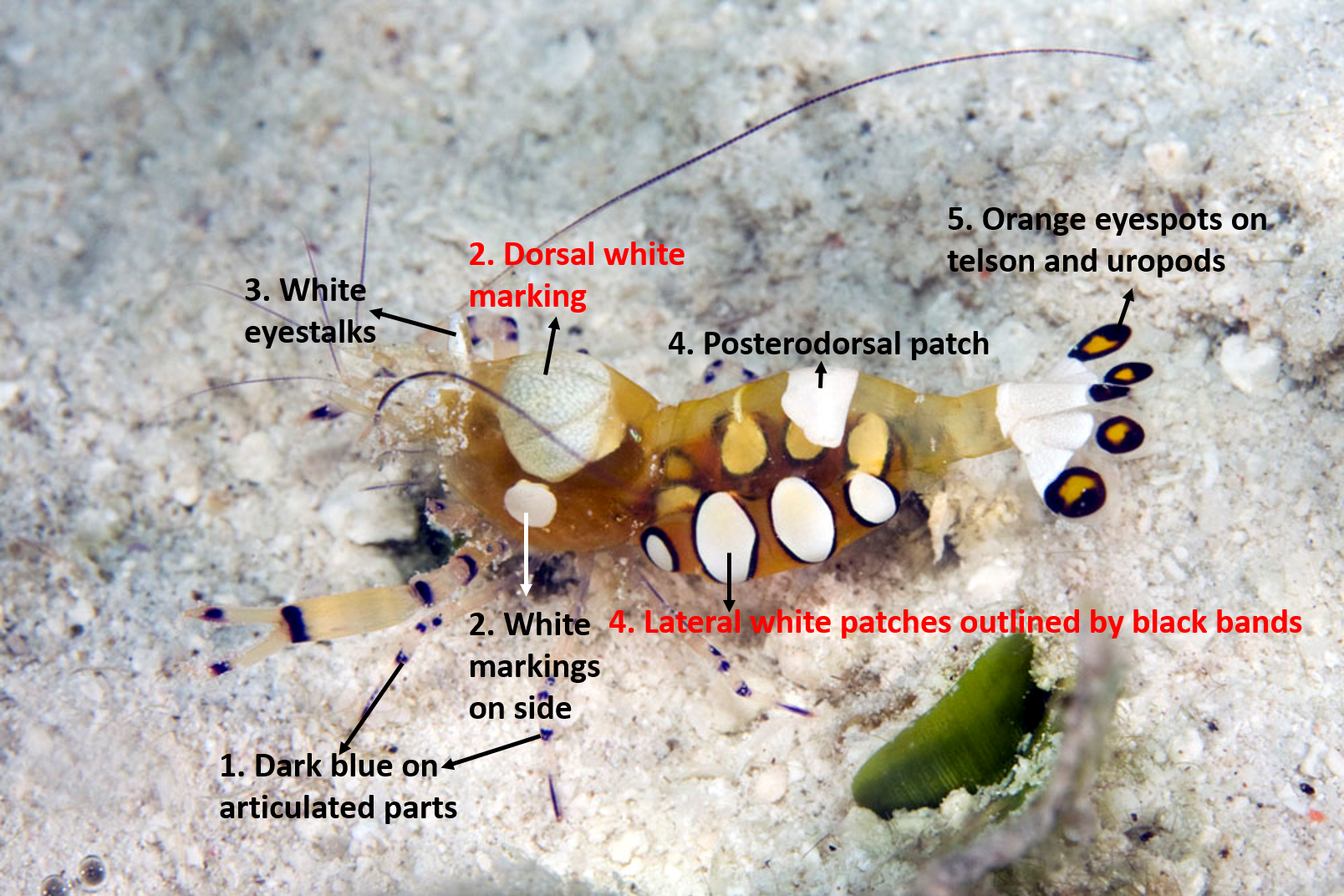 |
| Illustration of the live colouration description on a female specimen. Texts highlighted in red are characteristics unique to the females only. Adapted image by Dr Paddy Ryan. |
Specimens are almost transparent, save for some pigmented areas which differs between the male and female. Original description by Kemp (1922).
Ovigerous (bearing eggs) females in life are almost transparent except for pigmented areas as follows:
- Each articulated part of all the pereopod (walking limbs) is dark blue.
- The carapace (head shield) has the pure white markings on either side and on the dorsal (upperside) portion where the gonad is placed.
- In addition, the eyestalk and the part just behind the rostrum (forwards projecting spikey horn) on the dorsal side of the carapace are also white.
- The dorsal and lateral sides of the abdomen is covered with two pairs of the large, oval and white patches outlined by black bands laterally and the broad white patch situated on the posterodorsal (upperside and towards the end) side. Lateral patches are not seen in males.
- On the proximal half of the telson and each of the uropods there is a white, circular and broad ring followed by an orange eye-spot which is bordered by a dark, brown band. This is what gives the species its common name of the 5 spot anemone shrimp!
The female of this species grows to about 5cm long, while the males are smaller at 3cm.
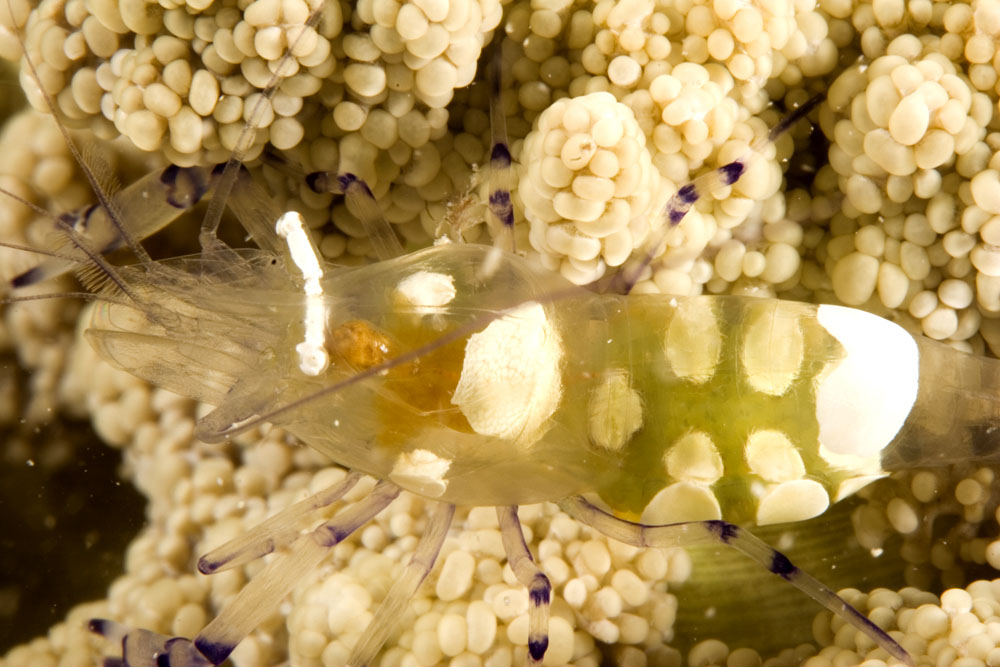 |
| A closer view of the white eyestalks. Image by Dr Paddy Ryan. |
5. Where can you find them?
This species can be found in the tropical Pacific and Indian Oceans, including Australia. This species has been recorded throughout the Indo-West Pacific region (Miyake and Fujino, 1968).| Distribution of P. brevicarpalis worldwide. Image adapted from Encyclopedia of Life. Creative commons. |
5.1 Where are they found in Singapore?
Periclimenes brevicarpalis has been found on local large sea anemones like the Giant carpet anemones (Stichodactyla gigantea), Haddon's carpet anemones (Stichodactyla haddoni), Magnificent anemones (Heteractis magnifica), Leathery anemone (Heteractis crispa) and Pizza anemone (Cryptodendrum adhaesivum).A Periclimenes brevicarpalis wandering around its apartment located at Cyrene Reefs, right in our backyard!
6. What do scientists and layman call it?
Binomial (a two part Latin name of an organism consisting of genus followed by its specific epithet): Periclimenes brevicarpalis (Schenkel) 1902Synonyms (scientific names that applies to a taxon that (now) goes by a different scientific name): Ancylocaris brevicarpalis Schenkel, Periclimenes (Harpilius) brevicarpalis
Vernacular (aka common names) : Five-spot anemone shrimp, Peacock tail anemone shrimp[10] , Glass Anemone Shrimp, pacific clown anemone shrimp, White Patched Anemone Shrimp [11]
Original description (for the taxonomists out there): not available online
7. Where is the original specimen of this species?
Species description and name of this species are given based on this type specimen. These specimens are usually stored in a museum so that scientists all over the world can come look at it, to compare with the specimens they have on hand.The morphological vouchers of Periclimenes brevicarpalis are housed at Ocean Genome Legacy
8. Phylogenetic information
Warning for the layman: section ahead may get too deep if you have no prior understanding, however may still be an interesting read if you want to expand your knowledge as common layman words are used to the best of my ability, otherwise links are provided for a deeper understanding. Enjoy!| Kingdom |
Animalia |
| Phylum |
Arthropoda |
| Subphylum |
Crustacea |
| Superclass |
Multicrustacea |
| Class |
Malacostraca |
| Subclass |
Eumalacostraca |
| Superorder |
Eucarida |
| Order |
Decapoda |
| Suborder |
Pleocyemata |
| Infraorder |
Caridea |
| Superfamily |
Palaemonoidea |
| Family |
Palaemonidae |
| Genus |
Periclimenes |
| Species |
Periclimenes brevicarpalis |
Each species of Periclimenes has adapted to a group of specific hosts, developing characteristics such as laterally compressed bodies to fit in narrow spaces within branching corals or having unarmed rostrum (a protrusion at the top of the carapace, usually with dorsal and ventral teeth) to preventing irritating the soft body of the host in the case of mollusk[13] .
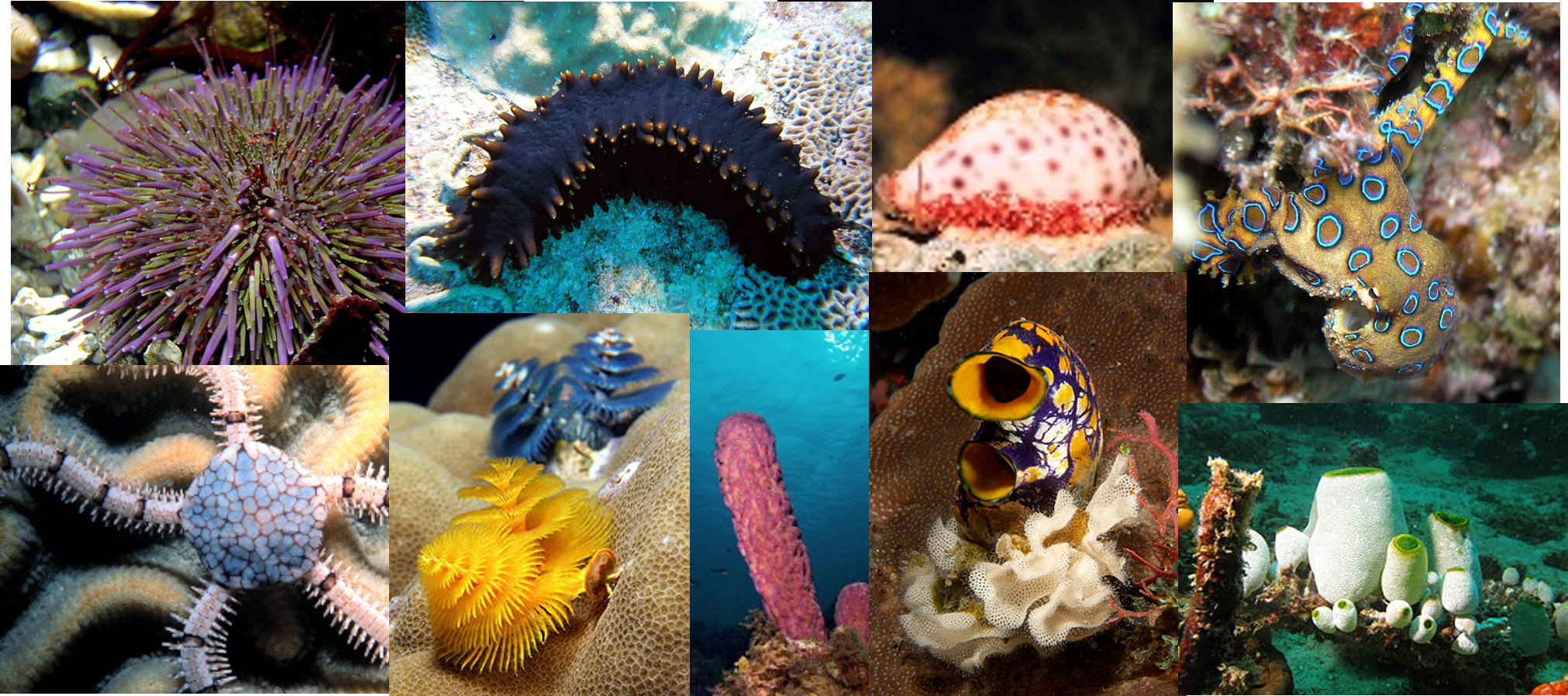 |
| An example of the array of organisms shrimps in the genus of Periclimenes can associate with. All images adapted from Wikipedia, Creative commons. |
Due to the variety of host specific relationships, Periclimenes is a species-rich group today. Previous classifications based solely on morphology may be inaccurate due to the diversity of this group as well as homoplasy, leading to Periclimenes being a polyphyletic group which can be observed in the phylogenetic tree below.
The species Periclimenes brevicarpalis (Schenkel, 1902) is closely related to Ancylomenes. The abdomen of the P. brevicarpalis is slightly humpbacked (and this can be observed in the above images of the 9th zoeal stage) which is a characteristic of Ancylomenes. For the taxonomists, a few other similar characters between these two genus according to Kou et al (2015)[14]
are as follows:
- subcylindrical body
- well-developed palaemonoid rostrum
- non-ovate inferior orbital angle
- feeble biungulate dactyls of the last three pereopods
- generally transparent body with mottled spots
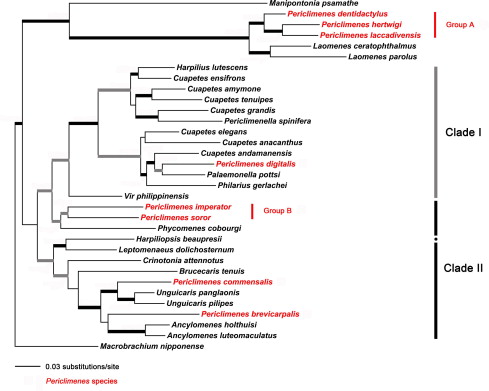 |
| Phylogenetic tree obtained by maximum likelihood analysis of three nuclear protein-coding genes, enolase, PEPCK and NaK, in addition to 16S rRNA. The branches strongly supported by both Maximum likelihood (BP ⩾ 60) and Bayesian inference (PP ⩾ 0.95) are indicated by thick black lines; the branches only strongly supported by one of the analyses are indicated with thick gray line. The branches with support both BP < 60 and PP < 0.95 are indicated by thin black lines. The Periclimenes species are marked in red. Image obtained from Kou et al. (2013), pending permission from publishers. |
9. Molecular information
Mitochondrial cytochrome oxidase I Sequence of voucher specimen: https://www.ncbi.nlm.nih.gov/nuccore/KU064990.110.External links
Local information on of Periclimenes brevicarpalis on Wild Singapore by Ria TanTaxonomic details of Periclimenes brevicarpalis on World Register of Marine Species (WoRMS)
Compilation of Periclimenes brevicarpalis information on Encyclopedia of Life (EOL)
11. Literature and References
Suzuki, K., & Hayashi, K. I. (1977). Five caridean shrimps associated with sea anemones in central Japan.
Khan, R. N., Becker, J. H., Crowther, A. L., & Lawn, I. D. (2004). Spatial distribution of symbiotic shrimps (Periclimenes holthuisi, P. brevicarpalis, Thor amboinensis) on the sea anemone Stichodactyla haddoni. Journal of the Marine Biological Association of the UK, 84(01), 201-203.
Gopalan Nayar, S. (1947). The newly hatched larva of Periclimenes (Ancylocaris) brevicarpalis (Schenkel). Proceedings: Plant Sciences, 26(4), 168-176.
Calado, R., Lin, J., Rhyne, A. L., Araújo, R., & Narciso, L. (2003). Marine ornamental decapods—popular, pricey, and poorly studied. Journal of crustacean biology, 23(4), 963-973.
Chace Jr, F. A. AJ Bruce. 1993. The Caridean shrimps (Crustacea: Decapoda) of the Albatross Philippine Expedition 1907-1910, Part 6: Superfamily Palaemonoidea. Smithsonian Contributions to Zoology, 543, 1-152.
Tan, R. (2016, Oct). Five-spot anemone shrimp. Retrieved from http://www.wildsingapore.com/wildfacts/crustacea/othercrust/shrimp/brevicarpalis.htm
Horká, I., De Grave, S., Fransen, C. H., Petrusek, A., & Ďuriš, Z. (2016). Multiple host switching events shape the evolution of symbiotic palaemonid shrimps (Crustacea: Decapoda). Scientific reports, 6, 26486.
Kou, Q., Li, X., Chan, T. Y., Chu, K. H., Huang, H., & Gan, Z. (2013). Phylogenetic relationships among genera of the Periclimenes complex (Crustacea: Decapoda: Pontoniinae) based on mitochondrial and nuclear DNA. Molecular Phylogenetics and Evolution, 68(1), 14-22.
Kou, Q., Li, X. Z., Chan, T. Y., & Chu, K. H. (2015). Divergent evolutionary pathways and host shifts among the commensal pontoniine shrimps: a preliminary analysis based on selected Indo-Pacific species. Organisms Diversity & Evolution, 15(2), 369-377